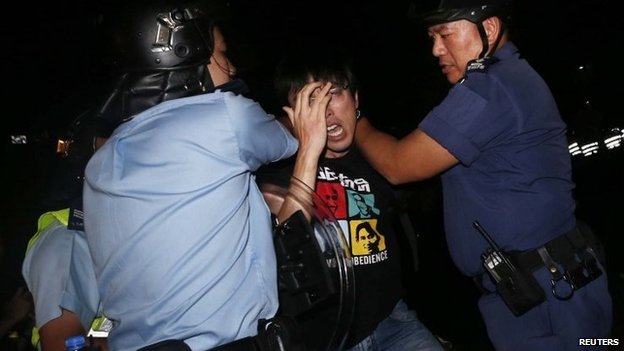
BBC Online : Hong Kong police have clashed with pro-democracy activists trying to surround government offices, in some of the worst unrest in two months of protests. Protesters fought police armed with pepper spray and batons on roads around the camp in the Admiralty district. Police say 40 people have been arrested and a number of officers were injured. The protesters want the people of Hong Kong to be allowed to choose their leaders in the 2017 elections without interference from Beijing. The Chinese government has said it will allow universal suffrage, but will screen candidates for the chief executive post in advance. Last week police and court bailiffs removed one of the major protest camps in the Mong Kok commercial district. The BBC’s Martin Patience in Beijing says that it seems clear that the authorities now want to take a hard line after two months of a soft approach. The protesters had public support at the beginning, but that is now ebbing as many Hong Kong residents believe the protests are causing too much disruption, says our correspondent. The unrest flared late on Sunday, after student protest leaders called on supporters to converge on the offices of Chief Executive CY Leung on Lung Wo Road. The road is a short distance away from Connaught Road in Admiralty, the major road protesters have been occupying for two months. Protesters, many wearing hard hats and carrying umbrellas – the symbol of their movement – moved into the area, throwing bottles, helmets and umbrellas towards police. Many activists chanted: “I want true democracy!” “I urge everyone to stay here until the morning to keep surrounding the government headquarters. Let’s stop the government from functioning tomorrow,” a protester in a black T-shirt shouted, Reuters news agency reported. Police ordered them to retreat, then charged protesters, eventually forcing them out of the area. ‘No choice’ “The action was aimed at paralysing the government’s operation,” student leader Alex Chow was quoted by the Associated Press as saying. “The government has been stalling… and we believe we need to focus pressure on the government headquarters, the symbol of the government’s power.” On Monday government offices were shut and staff were told to stay home. But the roads outside the government site were clear of protesters and open for traffic. By afternoon government employees were able to go back to work. The atmosphere remains tense at Connaught Road where hundreds of protesters are still occupying the area amid a police presence. Hong Kong’s security secretary, Lai Tung-kwow, has blamed students for escalating violent behaviour, and defended the use of force by police. “The police have to take resolute actions, they have no choice … it is their duty to restore law and order,” he told reporters at a press conference on Monday. Last week more than 100 people – including some key protest leaders – were arrested as the Mong Kok camp, across the harbour from Admiralty, was dismantled. The latest clashes come after China said it would not allow a UK parliamentary committee to enter Hong Kong as part of an inquiry into British relations with its former colony. Hong Kong democracy timeline 1984: Britain and China sign an agreement where Hong Kong is guaranteed “a high degree of autonomy, except in foreign and defence affairs” for 50 years following the handover in 1997.June-July 2014: Pro-democracy activists hold an unofficial referendum on political reform and a large rally. This is followed by protests by pro-Beijing activists.31 August 2014: China says it will allow direct elections in 2017, but voters will only be able to choose from a list of pre-approved candidates. Activists stage protests.22 September 2014: Student groups launch a week-long boycott of classes in protest.28 September 2014: Occupy Central and student protests join forces and take over central Hong Kong.October 2014: Chief Executive CY Leung dismisses demands for his resignation. Discussions between government and student leaders go nowhere. High court begins granting injunctions to clear protest sites.15 November 2014: Student leaders’ attempt to travel to Beijing fails. 18 November 2014: Bailiffs move in to clear a portion of the Admiralty protest site.26 November 2014: More than 100 arrests during clearance of Mong Kok site.2017: Direct elections for chief executive due to take place.

